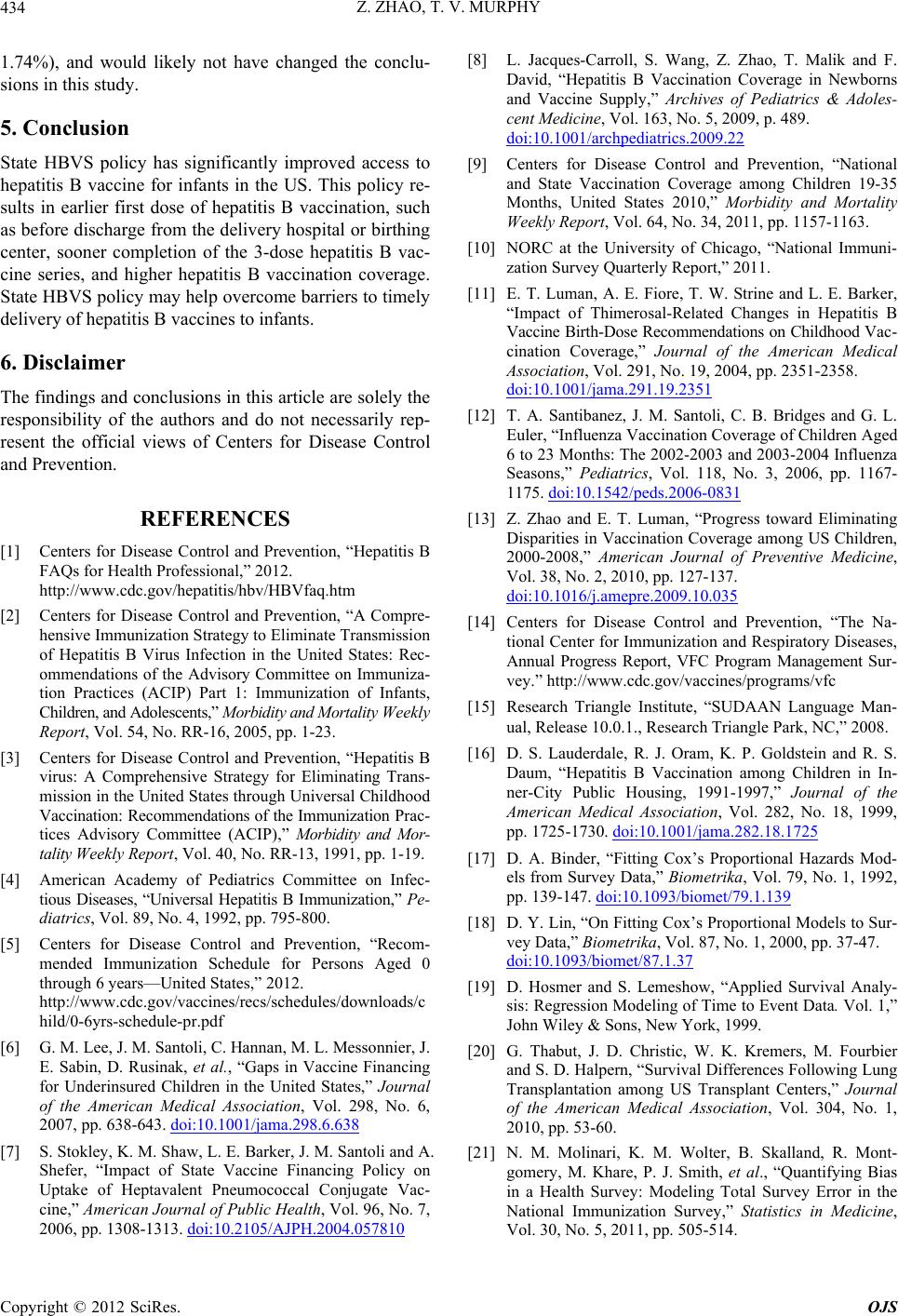
Z. ZHAO, T. V. MURPHY
Copyright © 2012 SciRes. OJS
434
1.74%), and would likely not have changed the conclu-
sions in this study.
5. Conclusion
State HBVS policy has significantly improved access to
hepatitis B vaccine for infants in the US. This policy re-
sults in earlier first dose of hepatitis B vaccination, such
as before discharge from the delivery hospital or birthing
center, sooner completion of the 3-dose hepatitis B vac-
cine series, and higher hepatitis B vaccination coverage.
State HBVS policy may help overcome barriers to timely
delivery of hepatitis B vaccines to infants.
6. Disclaimer
The findings and conclusions in this article are solely the
responsibility of the authors and do not necessarily rep-
resent the official views of Centers for Disease Control
and Prevention.
REFERENCES
[1] Centers for Disease Control and Prevention, “Hepatitis B
FAQs for Health Professional,” 2012.
http://www.cdc.gov/hepatitis/hbv/HBVfaq.htm
[2] Centers for Disease Control and Prevention, “A Compre-
hensive Immunization Strategy to Eliminate Transmission
of Hepatitis B Virus Infection in the United States: Rec-
ommendations of the Advisory Committee on Immuniza-
tion Practices (ACIP) Part 1: Immunization of Infants,
Children, and Adolescents,” Morbidity and Mortality Weekly
Report, Vol. 54, No. RR-16, 2005, pp. 1-23.
[3] Centers for Disease Control and Prevention, “Hepatitis B
virus: A Comprehensive Strategy for Eliminating Trans-
mission in the United States through Universal Childhood
Vaccination: Recommendations of the Immunization Prac-
tices Advisory Committee (ACIP),” Morbidity and Mor-
tal it y Weekly Report, Vol. 40, No. RR-13, 1991, pp. 1-19.
[4] American Academy of Pediatrics Committee on Infec-
tious Diseases, “Universal Hepatitis B Immunization,” Pe-
diatrics, Vol. 89, No. 4, 1992, pp. 795-800.
[5] Centers for Disease Control and Prevention, “Recom-
mended Immunization Schedule for Persons Aged 0
through 6 years—United States,” 2012.
http://www.cdc.gov/vaccines/recs/schedules/downloads/c
hild/0-6yrs-schedule-pr.pdf
[6] G. M. Lee, J. M. Santoli, C. Hannan, M. L. Messonnier, J.
E. Sabin, D. Rusinak, et al., “Gaps in Vaccine Financing
for Underinsured Children in the United States,” Journal
of the American Medical Association, Vol. 298, No. 6,
2007, pp. 638-643. doi:10.1001/jama.298.6.638
[7] S. Stokley, K. M. Shaw, L. E. Barker, J. M. Santoli and A.
Shefer, “Impact of State Vaccine Financing Policy on
Uptake of Heptavalent Pneumococcal Conjugate Vac-
cine,” American Journal of Public Health, Vol. 96, No. 7,
2006, pp. 1308-1313. doi:10.2105/AJPH.2004.057810
[8] L. Jacques-Carroll, S. Wang, Z. Zhao, T. Malik and F.
David, “Hepatitis B Vaccination Coverage in Newborns
and Vaccine Supply,” Archives of Pediatrics & Adoles-
cent Medicine, Vol. 163, No. 5, 2009, p. 489.
doi:10.1001/archpediatrics.2009.22
[9] Centers for Disease Control and Prevention, “National
and State Vaccination Coverage among Children 19-35
Months, United States 2010,” Morbidity and Mortality
Weekly Report, Vol. 64, No. 34, 2011, pp. 1157-1163.
[10] NORC at the University of Chicago, “National Immuni-
zation Survey Quarterly Report,” 2011.
[11] E. T. Luman, A. E. Fiore, T. W. Strine and L. E. Barker,
“Impact of Thimerosal-Related Changes in Hepatitis B
Vaccine Birth-Dose Recommendations on Childhood Vac-
cination Coverage,” Journal of the American Medical
Association, Vol. 291, No. 19, 2004, pp. 2351-2358.
doi:10.1001/jama.291.19.2351
[12] T. A. Santibanez, J. M. Santoli, C. B. Bridges and G. L.
Euler, “Influenza Vaccination Coverage of Children Aged
6 to 23 Months: The 2002-2003 and 2003-2004 Influenza
Seasons,” Pediatric s, Vol. 118, No. 3, 2006, pp. 1167-
1175. doi:10.1542/peds.2006-0831
[13] Z. Zhao and E. T. Luman, “Progress toward Eliminating
Disparities in Vaccination Coverage among US Children,
2000-2008,” American Journal of Preventive Medicine,
Vol. 38, No. 2, 2010, pp. 127-137.
doi:10.1016/j.amepre.2009.10.035
[14] Centers for Disease Control and Prevention, “The Na-
tional Center for Immunization and Respiratory Diseases,
Annual Progress Report, VFC Program Management Sur-
vey.” http://www.cdc.gov/vaccines/programs/vfc
[15] Research Triangle Institute, “SUDAAN Language Man-
ual, Release 10.0.1., Research Triangle Park, NC,” 2008.
[16] D. S. Lauderdale, R. J. Oram, K. P. Goldstein and R. S.
Daum, “Hepatitis B Vaccination among Children in In-
ner-City Public Housing, 1991-1997,” Journal of the
American Medical Association, Vol. 282, No. 18, 1999,
pp. 1725-1730. doi:10.1001/jama.282.18.1725
[17] D. A. Binder, “Fitting Cox’s Proportional Hazards Mod-
els from Survey Data,” Biometrika, Vol. 79, No. 1, 1992,
pp. 139-147. doi:10.1093/biomet/79.1.139
[18] D. Y. Lin, “On Fitting Cox’s Proportional Models to Sur-
vey Data,” Biometrika, Vol. 87, No. 1, 2000, pp. 37-47.
doi:10.1093/biomet/87.1.37
[19] D. Hosmer and S. Lemeshow, “Applied Survival Analy-
sis: Regression Modeling of Time to Event Data. Vol. 1,”
John Wiley & Sons, New York, 1999.
[20] G. Thabut, J. D. Christic, W. K. Kremers, M. Fourbier
and S. D. Halpern, “Survival Differences Following Lung
Transplantation among US Transplant Centers,” Journal
of the American Medical Association, Vol. 304, No. 1,
2010, pp. 53-60.
[21] N. M. Molinari, K. M. Wolter, B. Skalland, R. Mont-
gomery, M. Khare, P. J. Smith, et al., “Quantifying Bias
in a Health Survey: Modeling Total Survey Error in the
National Immunization Survey,” Statistics in Medicine,
Vol. 30, No. 5, 2011, pp. 505-514.